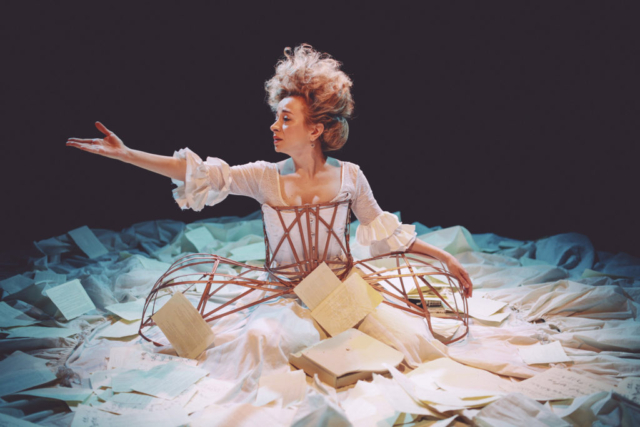Nannerl Mozart was a child prodigy like her brother Wolfgang Amadeus, but her musical career came to an end when she was 18. A one-woman play puts her back on the stage. In September 2015, on the occasion of the 100th performance of her play The Other Mozart, actress Sylvia Milo writes about her inspiration and process.
"I am writing to you with an erection on my head and I am very much afraid of burning my hair”, wrote Nannerl Mozart to her brother Wolfgang Amadeus. What was being erected was a large hairdo on top of Nannerl’s head, as she prepared to pose for the Mozart family portrait.
It was that hairdo that drew my attention. Nine years ago I was visiting Vienna for the 250th birthday celebrations of Wolfgang Amadeus, and I was thrilled to explore the city following in Wolfi’s footsteps, many of which turned out to be Nannerl’s as well. At the Mozarthaus Vienna – Wolfgang’s apartment – on the exit wall, as if by an afterthought, there was a little copy of the Mozart family portrait. I saw a woman seated at the harpsichord next to Wolfgang, their hands intertwined, playing together. I grew up studying to become a violinist. Neither my music history nor my repertoire included any female composers. With my braided hair I was called “little Mozart” by my violin teacher, but he meant Wolfi. I never heard that Amadeus had a sister. I never heard of Nannerl Mozart until I saw that family portrait.
I was intrigued and determined to find out more. I read Wolfgang Mozart biographies, studied the situation of women and female artists during Mozarts’ time and in different countries, read writings of Enlightenment philosophers, conduct manuals … But the richest source of information came from the Mozart family letters. There are hundreds, and we have them because Nannerl preserved them. Most are written by Leopold and Wolfgang but some of Nannerl’s letters survived as well. Through these letters, sometimes only from the replies to her lost letters, Nannerl slowly emerged. I was able to understand the Mozarts as people, as a family, and through the lens of the times and the social situation in which they lived. I saw Nannerl’s potential, her dreams, her strength, grace and her fight.
Maria Anna (called Marianne and nicknamed Nannerl) was – like her younger brother – a child prodigy. The children toured most of Europe (including an 18-month stay in London in 1764-5) performing together as “wunderkinder”. There are contemporaneous reviews praising Nannerl, and she was even billed first. Until she turned 18. A little girl could perform and tour, but a woman doing so risked her reputation. And so she was left behind in Salzburg, and her father only took Wolfgang on their next journeys around the courts of Europe. Nannerl never toured again.
But the woman I found did not give up. She wrote music and sent at least one composition to Wolfgang and Papa – Wolfgang praised it as “beautiful” and encouraged her to write more. Her father didn’t, as far as we know, say anything about it.
Did she stop? None of her music has survived. Perhaps she never showed it to anybody again, perhaps she destroyed it, maybe we will find it one day, maybe we already did but it’s wrongly attributed to her brother’s hand. Composing or performing music was not encouraged for women of her time. Wolfgang repeatedly wrote that nobody played his keyboard music as well as she could, and Leopold described her as “one of the most skilful players in Europe”, with “perfect insight into harmony and modulations” and that she improvises “so successfully that you would be astounded”.
Like Virginia Woolf’s imagined Shakespeare’s sister, Nannerl was not given the opportunity to thrive. And what she did create was not valued or preserved – most female composers from the past have been forgotten, their music lost or gathering dust in libraries. We will never know what could have been, and this is our loss.
Director Isaac Byrne and I searched for the ghost of Nannerl, and the story she needed to tell in my one-woman play. Period-style movement transports us to the Mozarts’ time using delicate gestures, court bows and curtsies, and the language of fans.
To create the 18th-century world of opulence and of restriction, the set became an enormous dress which spills over the entire stage (designed by Magdalena Dabrowska), with a corset/panniers cage on top. Finally the hair stands as tall as Nannerl’s, after we found the right hairspray to hold it all up-up-up – and yes, it is all my own hair.
Creating music for the show was down to two composers, Nathan Davis and Phyllis Chen, who chose, rather than to try to re-create Nannerl’s compositions, to portray her musical imagination, using the sounds she would have had in her ears: the fluttering of fans, tea cups, music boxes, bells, clavichords.
I’ve been touring The Other Mozart for the last two years: this month marks its 100th performance, how fitting that it will take place just a few steps away from where Nannerl performed in London as a girl.
It has been a long journey to bring Nannerl back to England after an absence of 250 years. I sometimes feel like Leopold Mozart – on a quest to show the world this brilliant Mozart.

